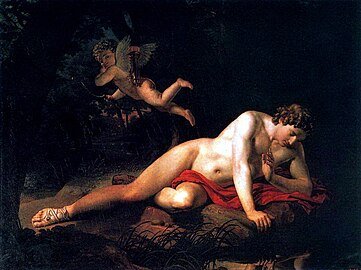Karl Bryullov
Karl Bryullov | |
|---|---|
| Карл Брюллов | |
 Self-portrait (1848) | |
| Born | Charles Bruleau 12 December 1799 |
| Died | 11 June 1852 (aged 52) |
| Resting place | Protestant Cemetery, Rome |
| Nationality | Russian |
| Alma mater | Imperial Academy of Arts (1821) |
| Known for | Painting and draughtsmanship |
| Movement | Romantic |
| Awards | |
| Elected | Professor by rank (1836) |
Karl Pavlovich Bryullov, also Briullov or Briuloff, born Charles Bruleau[1][2] (Russian: Карл Па́влович Брюлло́в; 23 December [O.S. 12 December] 1799 – 23 June [O.S. 11 June] 1852) was a Russian painter. He is regarded as a key figure in transition from the Russian neoclassicism to romanticism.
Biography
[edit]Karl Bryullov was born on 12 (23) December 1799 in St. Petersburg,[3] in the family of the academician, woodcarver, and engraver Pavel Ivanovich Briullo (Brulleau, 1760—1833) who was of Huguenot descent. He felt drawn to Italy from his early years. Despite his education at the Imperial Academy of Arts (1809–1821), Bryullov never fully embraced the classical style taught by his mentors and promoted by his brother, Alexander Bryullov. After distinguishing himself as a promising and imaginative student and finishing his education, he left Russia for Rome where he worked until 1835 as a portraitist and genre painter, though his fame as an artist came when he began doing historical painting.
His best-known work, The Last Day of Pompeii (1830–1833), is a vast composition compared by Pushkin and Gogol to the best works of Rubens and Van Dyck. It created a sensation in Italy and established Bryullov as one of the finest European painters of his day. After completing this work, he triumphantly returned to the Russian capital, where he made many friends among the aristocracy and intellectual elite and obtained a high post in the Imperial Academy of Arts.
An anecdote concerning Bryullov appeared in Leo Tolstoy's essay "Why Do Men Stupefy Themselves?" and later in the same author's book What Is Art?.
While teaching at the academy (1836–1848) he developed a portrait style which combined a neoclassical simplicity with a romantic tendency that fused well, and his penchant for realism was satisfied with an intriguing level of psychological penetration. While he was working on the plafond of St Isaac's Cathedral, his health suddenly deteriorated. Following advice of his doctors, Bryullov left Russia for Madeira in 1849 and spent the last three years of his life in Italy. He died in the village of Manziana near Rome and is buried at the Cimitero Acattolico there.
Characteristics of art
[edit]Bryullov's work is the pinnacle of late Russian Romanticism when the sense of harmonic wholeness and beauty of the world is replaced by a feeling of tragedy and conflict of life. In the forefront of the historical picture, but its main theme - not the struggle of heroes, as in classicism, and the fate of the huge human masses. In his central work "The Last Day of Pompeii" Bryullov combined the drama of action, romantic lighting effects and sculptural plasticity of figures. The painting brought the artist great fame both in Russia and in Europe.
An outstanding master of both ceremonial and chamber portraits, Bryullov evolved in his art from the joyful embrace of life in his early works to the intricate psychologism of his later ones, thus anticipating the achievements of such artists like Ilya Repin in the second half of the 19th century. Bryullov had an enormous influence on Russian artists, among whom he had many followers and imitators.[4]
Selected artwork
[edit]-
Narcissus, 1819, Russian Museum
-
A Dream of a Girl Before a Sunrise, 1830-1833, Pushkin Museum
-
Italian Morning, 1823, Kunsthalle Kiel
-
Italian Midday, 1827, Russian Museum
-
Bathsheba, 1832, Tretyakov Gallery
-
Girl, gathering grapes in the vicinity of Naples, 1827, Russian Museum
-
Fortuneteller Svetlana, 1836, Nizhny Novgorod State Art Museum
-
Portrait of Sophia Andreevna Bobrinskaya (Shuvalova), 1849, Hermitage Museum
-
Portrait of fabulist Ivan Andreyevich Krylov , 1839, Tretyakov Gallery
-
Portrait of Countess Julia Pavlovna Samoilova moving away from the ball with her adopted daughter Amazilia Pacini (Masquerade). Not later than 1842. Russian Museum
See also
[edit]References and notes
[edit]- ^ Karl Pavlovich Bryullov at the Encyclopædia Britannica
- ^ Agnieszka Świętosławska (2015). "Emigration as an artistic turning point – Ignacy Szczedrowski, Konstanty Kukiewicz and Tadeusz Gorecki at the Imperial Academy of Arts in Saint Petersburg". Art Inquiry (17). Łódzkie Towarzystwo Naukowe: 321–345.
- ^ Karl Pavlovich Bryullov at the Encyclopædia Britannica
- ^ Gosudarstvennyĭ russkiĭ muzeĭ; Государственный русский музей (1999). Karl Pavlovich Bri︠u︡llov, 1799-1852 : zhivopisʹ, risunki i akvareli iz sobranii︠a︡ Russkogo muzei︠a︡. V. A. Gusev, E. N. Petrova, G. N. Goldovskiĭ, В. А. Гусев, Е. Н. Петрова, Г. Н. Голдовский. [Saint Petersburg]: Palace Editions. ISBN 5-93332-011-0. OCLC 44796988.
Literature
[edit]- С. Н. Кондаков (1915). Юбилейный справочник Императорской Академии художеств. 1764-1914 (in Russian). Vol. 2. p. 25.
- Stepanova, Svetlana S. [in Russian] (2011). Русская живопись эпохи Карла Брюллова и Александра Иванова: Личность и художественный процесс (in Russian). Saint Petersburg: Iskusstvo-SPB. ISBN 978-5-210-01638-6. OCLC 706464182.
External links
[edit]- Paintings by Bryullov Karl - high res
- Online gallery of Briullov paintings
- Brullov's paintings at the Russian Art Gallery
- Karl Brulloff. The Last Day of Pompeii
- Imperial Academy of Arts alumni
- Awarded with a large gold medal of the Academy of Arts
- Academic staff of the Imperial Academy of Arts
- 1799 births
- 1852 deaths
- Painters from Saint Petersburg
- People from Sankt-Peterburgsky Uyezd
- Russian people of French descent
- Russian people of German descent
- Russian Orientalist painters
- Russian neoclassical painters
- Russian romantic painters
- 19th-century painters from the Russian Empire
- Burials in the Protestant Cemetery, Rome














